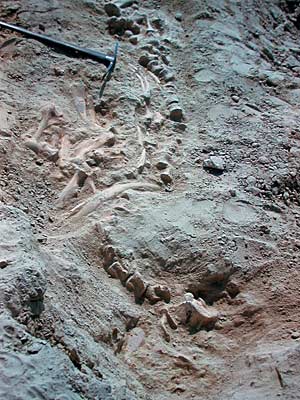 Once you have a field site, (as described in Getting Started) then you can get into the fun stuff: collecting the fossils. Collection is sometimes a very simple process, and a fossil is removed from the field in an afternoon. Other times, it is very challenging, taking years to complete.
Once you have a field site, (as described in Getting Started) then you can get into the fun stuff: collecting the fossils. Collection is sometimes a very simple process, and a fossil is removed from the field in an afternoon. Other times, it is very challenging, taking years to complete.In general, invertebrate and plant fossils fall under the first category. Invertebrates like ammonites, bacculites, clams, crabs, etc., can errode out of shales and be simply picked up off of the ground. They can also be found in limestones. Often times, if you take a rock hammer to a piece of limestone in a fossil-rich formation, you can find fragments of clams or other invertebrates inside.
Leaf fossils are found in a similar way. Paleobotanists determine a probable leaf site, then create a quarry with pickaxes, until leaves start appearing in the rocks. Then, using primarily rock hammers, they begin cracking open slabs of rock, looking for the fossils. These are then wrapped snugly in toilet paper, and put in cardboard flats to be transported.
Dinosaurs, and some mammals. tend to be much more difficult to collect. These larger creatures are preserved in the rocks, like other fossils, but are composed of many individual bones. These may cracked or distorted by the pressure of the earth and millions of years. Sometimes, the animals will be fully articulated; other times, multiple animals will be found jumbled up in a bone bed. The bones are also too fragile to be extracted with rock hammers and chisels, generally; dental picks and pneumatic equipment are more commonly the tools of choice. It takes hours to days of work to get a single bone ready for removal, assuming there are no complications (such as another bone being directly beneath it). Then, the bone has to be protected in a plaster cast before it can be removed. Eventually, though, a cast is ready to be popped out and taken out of the quarry.
Once fossils are collected, some dissappear into private collections. Many, however, go to a museum, where they are prepared for research or display.
For more information about how fossils are collected, visit the Denver Museum of Nature and Science website, and read the "Excavation" section.






